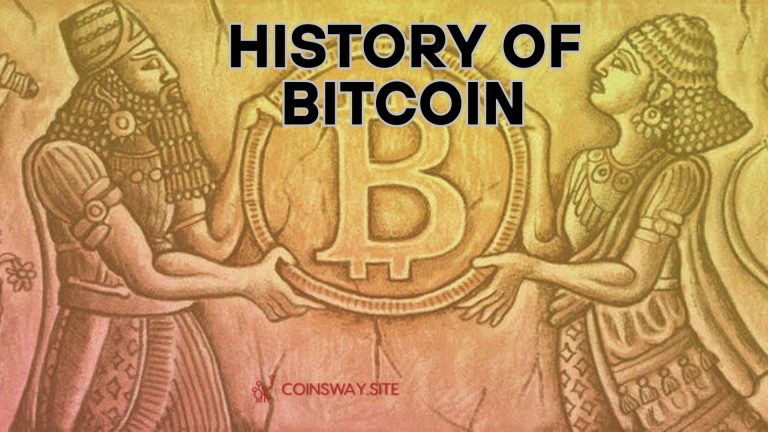History of Bitcoin: A response to the global financial crisis, Bitcoin, the first decentralised digital currency in history, initially surfaced in 2009. The enigmatic Satoshi Nakamoto invented Bitcoin, a groundbreaking peer-to-peer transaction system that does not require banks or a centralised authority.
History of Bitcoin: What started out as an experimental concept swiftly developed into a global financial movement that inspired the larger cryptocurrency industry and challenged established monetary systems. Bitcoin’s history is one of invention, upheaval, and growing acceptance in a rapidly digital world, from its humble beginnings to its role in revolutionising banking.
Bitcoin’s History: From Idea to Worldwide Phenomenon.
Bitcoin has transformed the way people think about money, finance, and digital sovereignty, going from a theoretical idea to a multitrillion-dollar ecosystem. Here is a thorough examination of its background, significant events, and revolutionary path.
The Genesis: Bitcoin’s Mysterious Origin (2008–2009).
Bitcoin was introduced to the world by an individual or group using the pseudonym Satoshi Nakamoto. The now-famous white paper “Bitcoin: A Peer-to-Peer Electronic Cash System” was published by Nakamoto in October 2008. This paper describes a groundbreaking method of sending money straight between people without using financial institutions.
Embedded in the block’s code was a message:
“The Times 03/Jan/2009 Chancellor on edge of second bailout for banks”—an allusion to the troubled centralised banking system and the current financial crisis.
This event marked the official birth of Bitcoin, although its value was essentially zero and its adoption was minimal at the time.
Early Adoption and Community Growth (2010–2012)
Software developers, libertarians, and cryptographers were the main groups that talked and experimented with Bitcoin in its early stages. Before a programmer named Laszlo Hanyecz made history on May 22, 2010, by paying 10,000 BTC for two pizzas, it had no practical use. Bitcoin Pizza Day is observed every year to honour this transaction, which at the time was only worth $41 and was the first known commercial use of Bitcoin.
The first Bitcoin exchanges appeared during this period. After its 2010 introduction, Mt. Gox quickly became the most popular Bitcoin/USD trading site.
The promise of Bitcoin as a worldwide and censorship-resistant currency started to draw interest.
Volatility, Regulation, and Media Attention (2013–2016)
Government scrutiny and media attention grew as a result. The FBI’s 2013 closure of the notorious Silk Road marketplace, which used Bitcoin to facilitate illegal items, strengthened the public’s perception of Bitcoin as being linked to crime and anonymity.
Bitcoin’s infrastructure kept expanding in spite of the bad press. Wallet services, merchant usage, and awareness all steadily increased.
>But when Mt. Gox declared bankruptcy in 2014 after losing over 850,000 Bitcoins, it exposed the dangers of centralized exchanges and sparked demands for increased security, shattering trust.
Maturation and Mainstream Interest (2017–2020)
Bitcoin grew at its fastest rate yet in 2017. As initial coin offerings (ICOs) flourished and institutional interest increased. The price of Bitcoin shot up to an all-time high of about $20,000 in December. Millions of people were first exposed to cryptocurrencies during this bull run.
In 2018, however, the spike was followed by a sharp correction that became known as the “crypto winter”. Many projects failed, and prices plummeted. Notwithstanding the recession, this time frame set the stage for significant advancements in institutional participation, regulation, and infrastructure.
The COVID-19 epidemic in 2020 caused economic instability around the world. Bitcoin started to be seen more and more as “digital gold”—a hedge against inflation. Demand and trustworthiness were greatly increased when big businesses like Tesla emerged. Square and MicroStrategy started buying Bitcoin as part of their treasury strategy.
The Era of Institutional Adoption and Global Debate (2021–Present)
The year 2021 was a watershed for Bitcoin. El Salvador became the first nation to accept Bitcoin as legal tender in November. When the price reached an all-time high of almost $68,000. This historic action generated both excitement and outrage.
Global regulatory debates grew more heated at the same time. Due to China’s restrictions on Bitcoin mining, mining activities have drastically shifted to other nations, such as Kazakhstan and the United States.
Concerns about Bitcoin’s energy consumption and environmental impact spurred interest in more ecologically friendly mining techniques.
Meanwhile, a second-layer scaling solution called the Lightning Network began to be implemented in the real world, which sped up and reduced the cost of Bitcoin transactions, especially for micropayments and remittances.
Conclusion.
The history of Bitcoin is one of invention, debate, tenacity, and development. Bitcoin has transformed the way people think about money, decentralisation, and financial sovereignty from a little-known white paper. To a major worldwide financial tool. Bitcoin’s fundamental ideas of scarcity, decentralisation, and transparency continue to motivate both supporters. And detractors, despite its continued volatility and controversy.
However, Bitcoin’s future will probably be influenced by ongoing adoption, regulation, and technological developments. And the global discourse surrounding digital money as it moves further into the 2020s.
The enigmatic Satoshi Nakamoto invented Bitcoin, a groundbreaking peer-to-peer transaction system that does not require banks or a centralised authority.
What started out as an experimental concept swiftly developed into a global financial movement that inspired the larger cryptocurrency industry. And challenged established monetary systems. Bitcoin’s history is one of invention, upheaval, and growing acceptance. In a rapidly digital world from its humble beginnings. To its role in revolutionising banking.


